Sophia Althammer
Command A: An Enterprise-Ready Large Language Model
Apr 01, 2025



Abstract:In this report we describe the development of Command A, a powerful large language model purpose-built to excel at real-world enterprise use cases. Command A is an agent-optimised and multilingual-capable model, with support for 23 languages of global business, and a novel hybrid architecture balancing efficiency with top of the range performance. It offers best-in-class Retrieval Augmented Generation (RAG) capabilities with grounding and tool use to automate sophisticated business processes. These abilities are achieved through a decentralised training approach, including self-refinement algorithms and model merging techniques. We also include results for Command R7B which shares capability and architectural similarities to Command A. Weights for both models have been released for research purposes. This technical report details our original training pipeline and presents an extensive evaluation of our models across a suite of enterprise-relevant tasks and public benchmarks, demonstrating excellent performance and efficiency.
Replacing Judges with Juries: Evaluating LLM Generations with a Panel of Diverse Models
May 01, 2024



Abstract:As Large Language Models (LLMs) have become more advanced, they have outpaced our abilities to accurately evaluate their quality. Not only is finding data to adequately probe particular model properties difficult, but evaluating the correctness of a model's freeform generation alone is a challenge. To address this, many evaluations now rely on using LLMs themselves as judges to score the quality of outputs from other LLMs. Evaluations most commonly use a single large model like GPT4. While this method has grown in popularity, it is costly, has been shown to introduce intramodel bias, and in this work, we find that very large models are often unnecessary. We propose instead to evaluate models using a Panel of LLm evaluators (PoLL). Across three distinct judge settings and spanning six different datasets, we find that using a PoLL composed of a larger number of smaller models outperforms a single large judge, exhibits less intra-model bias due to its composition of disjoint model families, and does so while being over seven times less expensive.
Annotating Data for Fine-Tuning a Neural Ranker? Current Active Learning Strategies are not Better than Random Selection
Sep 12, 2023Abstract:Search methods based on Pretrained Language Models (PLM) have demonstrated great effectiveness gains compared to statistical and early neural ranking models. However, fine-tuning PLM-based rankers requires a great amount of annotated training data. Annotating data involves a large manual effort and thus is expensive, especially in domain specific tasks. In this paper we investigate fine-tuning PLM-based rankers under limited training data and budget. We investigate two scenarios: fine-tuning a ranker from scratch, and domain adaptation starting with a ranker already fine-tuned on general data, and continuing fine-tuning on a target dataset. We observe a great variability in effectiveness when fine-tuning on different randomly selected subsets of training data. This suggests that it is possible to achieve effectiveness gains by actively selecting a subset of the training data that has the most positive effect on the rankers. This way, it would be possible to fine-tune effective PLM rankers at a reduced annotation budget. To investigate this, we adapt existing Active Learning (AL) strategies to the task of fine-tuning PLM rankers and investigate their effectiveness, also considering annotation and computational costs. Our extensive analysis shows that AL strategies do not significantly outperform random selection of training subsets in terms of effectiveness. We further find that gains provided by AL strategies come at the expense of more assessments (thus higher annotation costs) and AL strategies underperform random selection when comparing effectiveness given a fixed annotation cost. Our results highlight that ``optimal'' subsets of training data that provide high effectiveness at low annotation cost do exist, but current mainstream AL strategies applied to PLM rankers are not capable of identifying them.
Ranger: A Toolkit for Effect-Size Based Multi-Task Evaluation
May 24, 2023


Abstract:In this paper, we introduce Ranger - a toolkit to facilitate the easy use of effect-size-based meta-analysis for multi-task evaluation in NLP and IR. We observed that our communities often face the challenge of aggregating results over incomparable metrics and scenarios, which makes conclusions and take-away messages less reliable. With Ranger, we aim to address this issue by providing a task-agnostic toolkit that combines the effect of a treatment on multiple tasks into one statistical evaluation, allowing for comparison of metrics and computation of an overall summary effect. Our toolkit produces publication-ready forest plots that enable clear communication of evaluation results over multiple tasks. Our goal with the ready-to-use Ranger toolkit is to promote robust, effect-size-based evaluation and improve evaluation standards in the community. We provide two case studies for common IR and NLP settings to highlight Ranger's benefits.
TripJudge: A Relevance Judgement Test Collection for TripClick Health Retrieval
Aug 14, 2022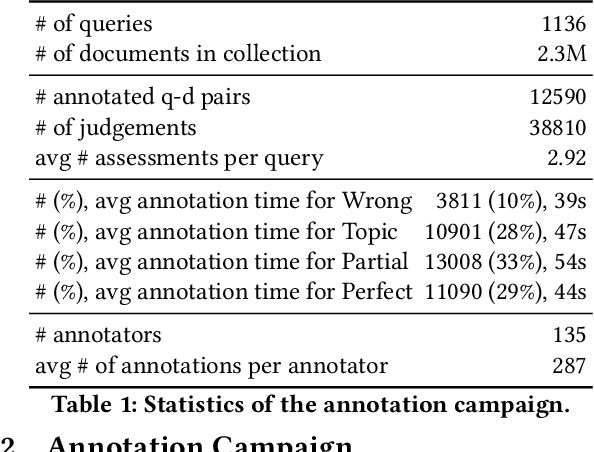
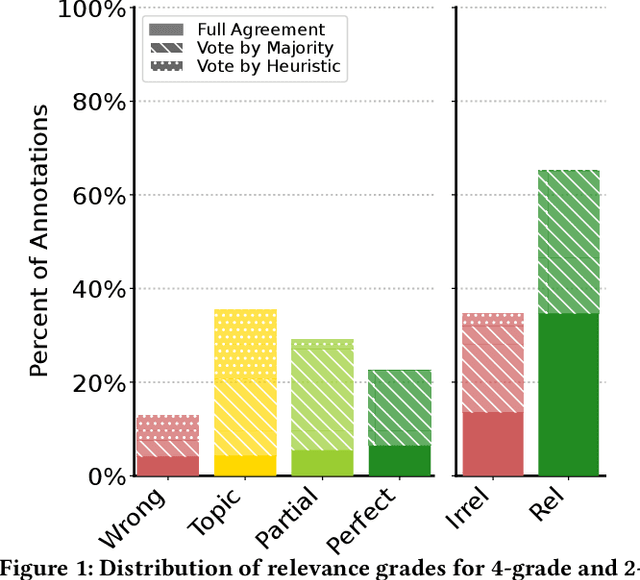
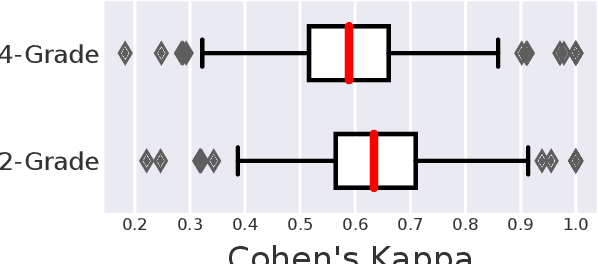

Abstract:Robust test collections are crucial for Information Retrieval research. Recently there is a growing interest in evaluating retrieval systems for domain-specific retrieval tasks, however these tasks often lack a reliable test collection with human-annotated relevance assessments following the Cranfield paradigm. In the medical domain, the TripClick collection was recently proposed, which contains click log data from the Trip search engine and includes two click-based test sets. However the clicks are biased to the retrieval model used, which remains unknown, and a previous study shows that the test sets have a low judgement coverage for the Top-10 results of lexical and neural retrieval models. In this paper we present the novel, relevance judgement test collection TripJudge for TripClick health retrieval. We collect relevance judgements in an annotation campaign and ensure the quality and reusability of TripJudge by a variety of ranking methods for pool creation, by multiple judgements per query-document pair and by an at least moderate inter-annotator agreement. We compare system evaluation with TripJudge and TripClick and find that that click and judgement-based evaluation can lead to substantially different system rankings.
Introducing Neural Bag of Whole-Words with ColBERTer: Contextualized Late Interactions using Enhanced Reduction
Mar 24, 2022
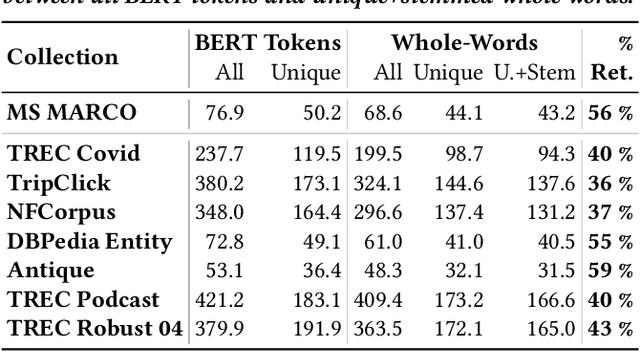

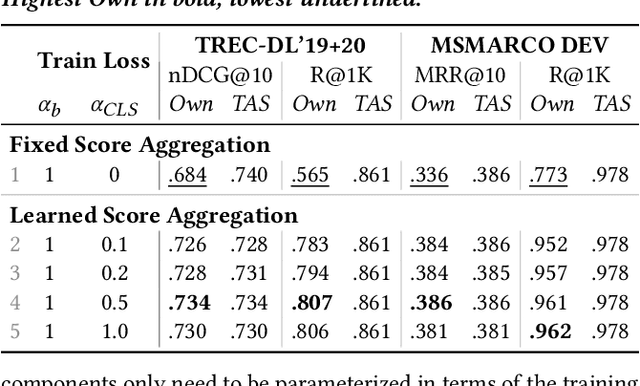
Abstract:Recent progress in neural information retrieval has demonstrated large gains in effectiveness, while often sacrificing the efficiency and interpretability of the neural model compared to classical approaches. This paper proposes ColBERTer, a neural retrieval model using contextualized late interaction (ColBERT) with enhanced reduction. Along the effectiveness Pareto frontier, ColBERTer's reductions dramatically lower ColBERT's storage requirements while simultaneously improving the interpretability of its token-matching scores. To this end, ColBERTer fuses single-vector retrieval, multi-vector refinement, and optional lexical matching components into one model. For its multi-vector component, ColBERTer reduces the number of stored vectors per document by learning unique whole-word representations for the terms in each document and learning to identify and remove word representations that are not essential to effective scoring. We employ an explicit multi-task, multi-stage training to facilitate using very small vector dimensions. Results on the MS MARCO and TREC-DL collection show that ColBERTer can reduce the storage footprint by up to 2.5x, while maintaining effectiveness. With just one dimension per token in its smallest setting, ColBERTer achieves index storage parity with the plaintext size, with very strong effectiveness results. Finally, we demonstrate ColBERTer's robustness on seven high-quality out-of-domain collections, yielding statistically significant gains over traditional retrieval baselines.
PARM: A Paragraph Aggregation Retrieval Model for Dense Document-to-Document Retrieval
Jan 05, 2022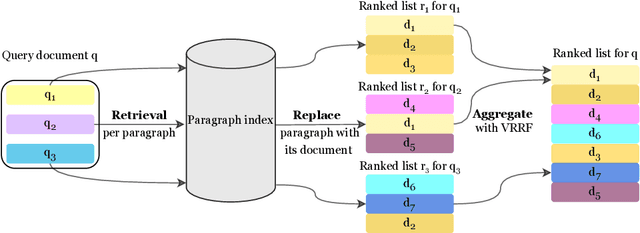

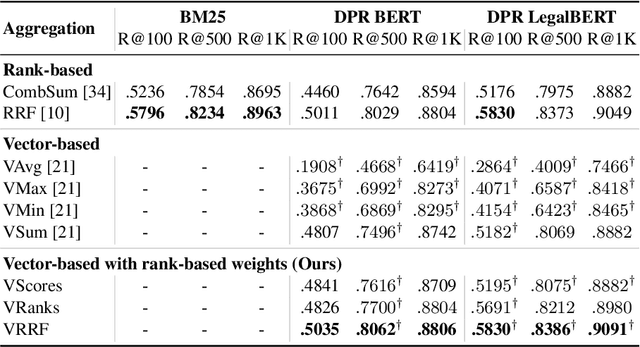
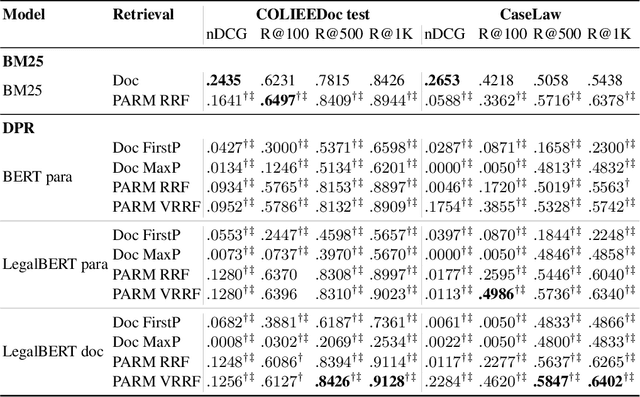
Abstract:Dense passage retrieval (DPR) models show great effectiveness gains in first stage retrieval for the web domain. However in the web domain we are in a setting with large amounts of training data and a query-to-passage or a query-to-document retrieval task. We investigate in this paper dense document-to-document retrieval with limited labelled target data for training, in particular legal case retrieval. In order to use DPR models for document-to-document retrieval, we propose a Paragraph Aggregation Retrieval Model (PARM) which liberates DPR models from their limited input length. PARM retrieves documents on the paragraph-level: for each query paragraph, relevant documents are retrieved based on their paragraphs. Then the relevant results per query paragraph are aggregated into one ranked list for the whole query document. For the aggregation we propose vector-based aggregation with reciprocal rank fusion (VRRF) weighting, which combines the advantages of rank-based aggregation and topical aggregation based on the dense embeddings. Experimental results show that VRRF outperforms rank-based aggregation strategies for dense document-to-document retrieval with PARM. We compare PARM to document-level retrieval and demonstrate higher retrieval effectiveness of PARM for lexical and dense first-stage retrieval on two different legal case retrieval collections. We investigate how to train the dense retrieval model for PARM on limited target data with labels on the paragraph or the document-level. In addition, we analyze the differences of the retrieved results of lexical and dense retrieval with PARM.
Establishing Strong Baselines for TripClick Health Retrieval
Jan 02, 2022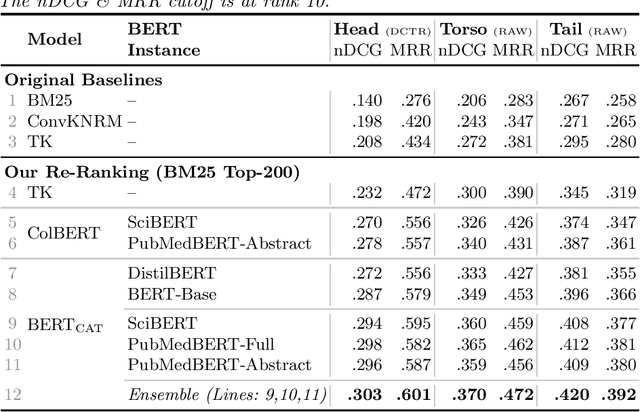
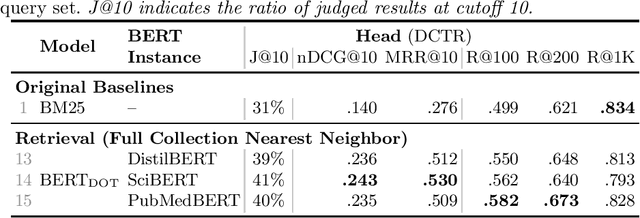
Abstract:We present strong Transformer-based re-ranking and dense retrieval baselines for the recently released TripClick health ad-hoc retrieval collection. We improve the - originally too noisy - training data with a simple negative sampling policy. We achieve large gains over BM25 in the re-ranking task of TripClick, which were not achieved with the original baselines. Furthermore, we study the impact of different domain-specific pre-trained models on TripClick. Finally, we show that dense retrieval outperforms BM25 by considerable margins, even with simple training procedures.
A Time-Optimized Content Creation Workflow for Remote Teaching
Oct 13, 2021
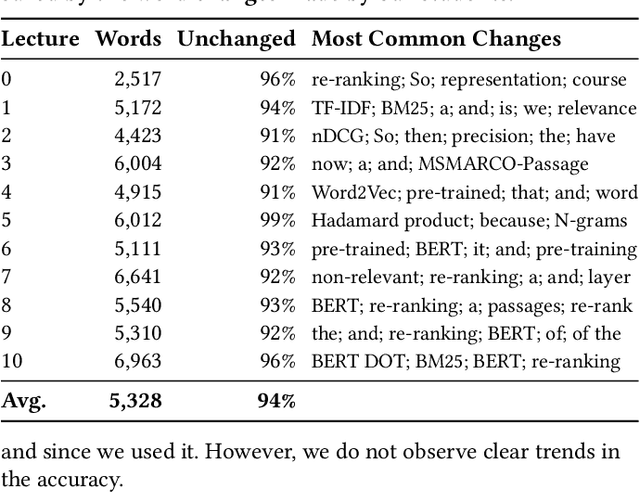

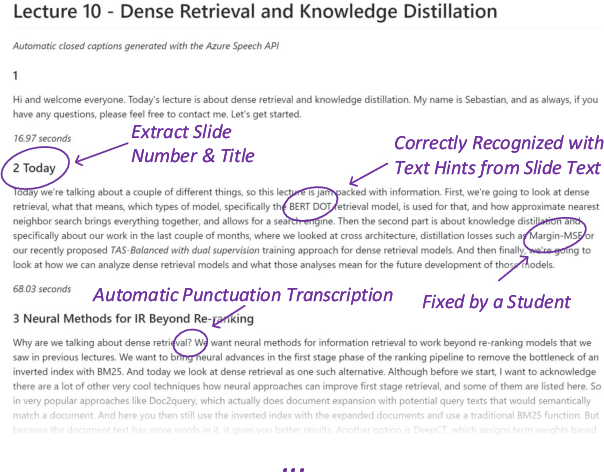
Abstract:We describe our workflow to create an engaging remote learning experience for a university course, while minimizing the post-production time of the educators. We make use of ubiquitous and commonly free services and platforms, so that our workflow is inclusive for all educators and provides polished experiences for students. Our learning materials provide for each lecture: 1) a recorded video, uploaded on YouTube, with exact slide timestamp indices, which enables an enhanced navigation UI; and 2) a high-quality flow-text automated transcript of the narration with proper punctuation and capitalization, improved with a student participation workflow on GitHub. All these results could be created by hand in a time consuming and costly way. However, this would generally exceed the time available for creating course materials. Our main contribution is to automate the transformation and post-production between raw narrated slides and our published materials with a custom toolchain. Furthermore, we describe our complete workflow: from content creation to transformation and distribution. Our students gave us overwhelmingly positive feedback and especially liked our use of ubiquitous platforms. The most used feature was YouTube's chapter UI enabled through our automatically generated timestamps. The majority of students, who started using the transcripts, continued to do so. Every single transcript was corrected by students, with an average word-change of 6%. We conclude with the positive feedback that our enhanced content formats are much appreciated and utilized. Important for educators is how our low overhead production workflow was sustainable throughout a busy semester.
Description-based Label Attention Classifier for Explainable ICD-9 Classification
Sep 24, 2021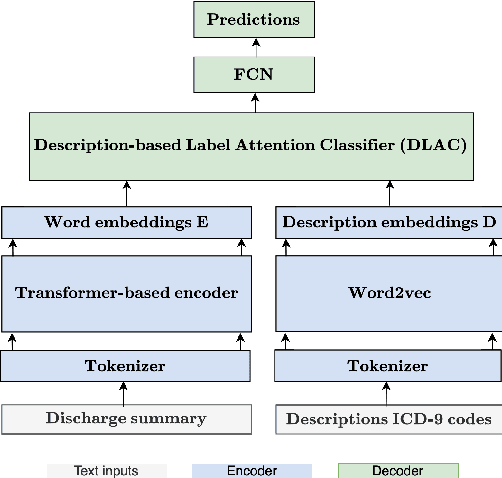
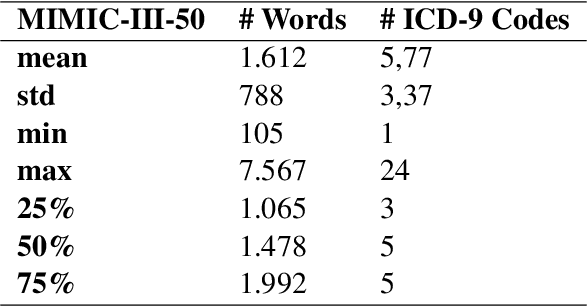
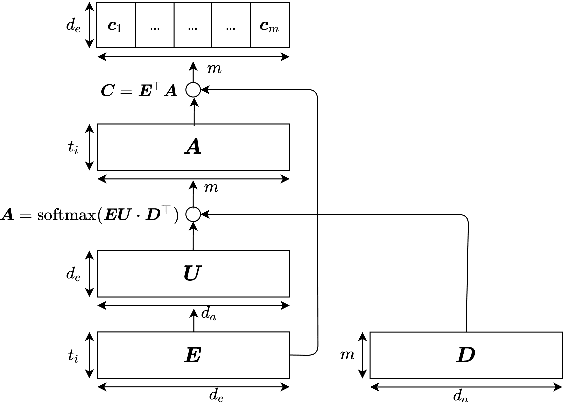
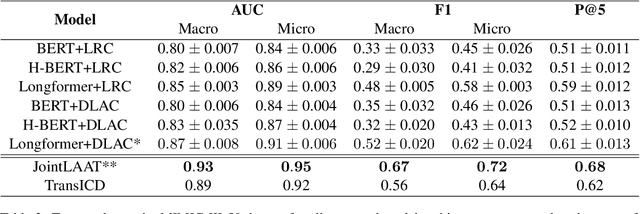
Abstract:ICD-9 coding is a relevant clinical billing task, where unstructured texts with information about a patient's diagnosis and treatments are annotated with multiple ICD-9 codes. Automated ICD-9 coding is an active research field, where CNN- and RNN-based model architectures represent the state-of-the-art approaches. In this work, we propose a description-based label attention classifier to improve the model explainability when dealing with noisy texts like clinical notes. We evaluate our proposed method with different transformer-based encoders on the MIMIC-III-50 dataset. Our method achieves strong results together with augmented explainablilty.
 Add to Chrome
Add to Chrome Add to Firefox
Add to Firefox Add to Edge
Add to Edge